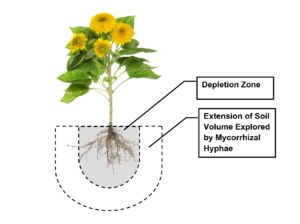Plants have evolved several mechanisms to interact with microorganisms to acquire resources from the soil. One of the most widespread mutualistic relationships is arbuscular mycorrhizal symbiosis, which is formed by arbuscular mycorrhizal fungi (AMF) in association with the majority of land plants including almost all major agricultural and ornamental crops and herbaceous and shrub species in natural ecosystems. The symbiosis is characterized by carbon (e.g., sugar, lipids) flows from the plant to the fungus and inorganic nutrients and water movement to the plant, thereby providing a critical linkage between the plant and the soil.
 After the colonization of the root tissues, mycorrhizal fungi develop an external mycelium which is a bridge connecting the root with the surrounding soil microhabitats. Mycorrhizal mycelium serve as extended arms of the plant root system increasing the nutrient and water absorption of the plants. In field conditions, plant roots are limited to a small soil volume for absorption of nutrients, called depletion zone. The depletion zone is particularly important for immobile nutrients such as phosphorus. To obtain more phosphorus, plants must overcome the limitations of this depletion zone. Mycorrhizal hyphae serve this very purpose by reaching out of the depletion zone, and improving the ability of the plant to access additional soil resources. Hyphae can grow up to 20-24 inches in length. With the addition of mycorrhizal, crop plant uptake and utilization of fertilizer inputs becomes far more efficient, often leading to significant savings in fertilizer costs.
After the colonization of the root tissues, mycorrhizal fungi develop an external mycelium which is a bridge connecting the root with the surrounding soil microhabitats. Mycorrhizal mycelium serve as extended arms of the plant root system increasing the nutrient and water absorption of the plants. In field conditions, plant roots are limited to a small soil volume for absorption of nutrients, called depletion zone. The depletion zone is particularly important for immobile nutrients such as phosphorus. To obtain more phosphorus, plants must overcome the limitations of this depletion zone. Mycorrhizal hyphae serve this very purpose by reaching out of the depletion zone, and improving the ability of the plant to access additional soil resources. Hyphae can grow up to 20-24 inches in length. With the addition of mycorrhizal, crop plant uptake and utilization of fertilizer inputs becomes far more efficient, often leading to significant savings in fertilizer costs.
Aside from the extention that mycorrhizal fungi can provide out into the soil, they have other specialized ways in which they can help plants exploit the nutrients in their rhizosphere and more efficiently utilize nutrients.
-
Mycorrhizae can help solubilize tightly bound nutrients
- Mycorrhizal fungi produce enzymes that convert non-soluble nutrients into bio-available forms or soluble forms, and then absorb and deliver those nutrients directly to the plants’ root systems.
- The mycorrhizal symbiosis can increase the production of solubilizing enzymes by the plants themselves, also helping to make tightly bound nutrients accessible.
- Mycorrhizae also work together with other soil microorganisms, which help the fungus extract more nutrients for the plant.
- Research confirms that mycorrhizae are particularly important in mobilizing phosphorus, nitrogen, zinc, iron, calcium, magnesium, manganese, sulfur and other important soil nutrients by enzymatic release from tightly held chemical bonds and transporting them back to the plant.
-
Mycorrhizal fungi reduce nutrient runoff
- The additional absorptive surface area provided by mycorrhizal mycelium ensure that more of the nutrients from fertilizers are absorbed and utilized, reducing the amount that is wasted via runoff.
- Not only does this avoid the financial waste of these inputs running off into the ground water rather than being utilized by the plant, this also has an ecological benefit, reducing the negative impact that this nutrient runoff can have on waterways and groundwater.
-
Mycorrhizae can mitigate negative effects of over fertilization
- Through the buffering effect that mycorrhizal provide, which protect plants from toxic conditions, heavy metals, salts, etc., the mycorrhizal can also hold onto nutrients that are over-applied, and sequester them to protect the plant.

